Population Dynamics of Chrysichthys nigrodigitatus (Lacépède, 1803) in a Tropical Man-Made Lake, Southwestern Nigeria
| Received 29 Mar, 2025 |
Accepted 23 Jun, 2025 |
Published 30 Sep, 2025 |
Background and Objective: The concern over probable loss of biological diversity and ecosystem function informed the updating of information on Chrysichthys nigrodigitatus population dynamics for sustainable management. This study, thus, aims to determine the population parameters of C. nigrodigitatus in Asejire Lake, Oyo State, Nigeria. Materials and Methods: Samples of the C. nigrodigitatus were obtained bi-monthly from Asejire reservoir landing sites between February and July, 2024. Total length (TL), fork length, standard length, and body weight (BW) were taken to precision. Length-weight relationships, condition factors, and growth parameters were estimated following standard methods. Mortality rate, longevity, and exploitation rate were determined using FSAT software. Data were analysed using descriptive statistics, multiple linear regression, and ANOVA at α0.05. Results: The TL ranged from 13.55 to 40.30 cm with a mean at 24.41±0.31, while BW varied from 11.00 to 320.00 g. Length-weight relationships and condition factor were 2.93 and 0.51±0.13, respectively. The length at infinity (L∞), growth coefficient (k), longevity, and exploitation status were 36.07 (cm), 0.38 (year–1), 3.5 (years), and 0.75 (>0.5), respectively. The total mortality, Z, was 2.54 year–1, while natural mortality and fishing mortality were 0.67 and 1.91 year–1, respectively. Conclusion: The growth coefficient revealed that the C. nigrodigitatus in Asejire reservoir is a fast-growing and short-lived species with an isometric growth pattern but a low condition factor. There is a need to improve the condition of the lake and adopt more sustainable management strategies to enhance the stock of C. nigrodigitatus in Asejire Lake, Nigeria.
| Copyright © 2025 Kazeem et al. This is an open-access article distributed under the Creative Commons Attribution License, which permits unrestricted use, distribution, and reproduction in any medium, provided the original work is properly cited. |
INTRODUCTION
Silver catfish, Chrysichthys nigrodigitatus, is a widespread and economically important freshwater fish species for artisanal fishery in Nigeria. It provides good quality fish with white and very tasty flesh, serving as a delicacy for the teeming populace, especially in riverine communities1. Silver catfish is a vital resource for local communities, contributing to their economy, livelihoods, and nutritional needs. This carnivorous species is ecologically important for maintaining the freshwater ecosystem dynamics. Of recent stock of C. nigrodigitatus and many others are reducing in our waterbodies due to unscrupulous exploitation occasioned by population expansion and improved fishing technology2. The concern over foreseeable loss of biological diversity and ecosystem function, informed by updated information on population dynamics for sustainable management3.
The surge in population and industries around the Asejire area has contributed to the depletion of fish stock in the Lake, where catches in recent times are mostly juvenile sizes and consequently exposed valuable resident species such as C. nigrodigitatus to the risk of extinction4. To achieve sustainable exploitation and effective management, data on fish biology and population dynamics are essential5. Understanding the growth, mortality, weight, and longevity of C. nigrodigitatus in Asejire Reservoir, Nigeria, is crucial for effective fisheries management and conservation in this environment. The growth patterns, biomass distributions, and survival rates of C. nigrodigitatus may differ significantly from those in natural habitats compared to constantly changing reservoir conditions6. Overall, this study is not only significant for the sustainable management of C. nigrodigitatus populations in Asejire Lake but will also contribute to broader efforts in managing fish resources in tropical man-made lakes across Nigeria and other regions with similar ecosystems7.
Thus, this study aimed to provide information on the growth, mortality, and longevity of silver catfish inhabiting the Asejire Lake, Nigeria.
MATERIALS AND METHODS
Study area: Asejire Lake is an artificial depression approximately 30 km East of Ibadan, between Latitudes 7°21'30"-7°21'50"N, and Longitudes 4°07'30"-4°08'10"E, at an altitude of 137 m.a.s.l.8. The Asejire basin is inundated by floodwater from two main Rivers (i.e., Rivers Oshun and Oba), forming two unequal arms of a Y-shaped (Fig. 1). It is a freshwater Lake with a deepest point of 19 m and a surface area of 24 km2. In addition to its role in irrigation, flood control, and potable water supply, artisanal fishing is remarkably prominent in the Lake.
Fish collection: In all, 629 C. nigrodigitatus samples were obtained bimonthly from the lake between February to July, 2024. The fish were transported to the Wet laboratory, Department of Aquaculture and Fisheries Management, University of Ibadan, Nigeria, where lengths (FL and TL ±0.1 cm) and body weight, ±0.01 g) of each specimen were recorded.
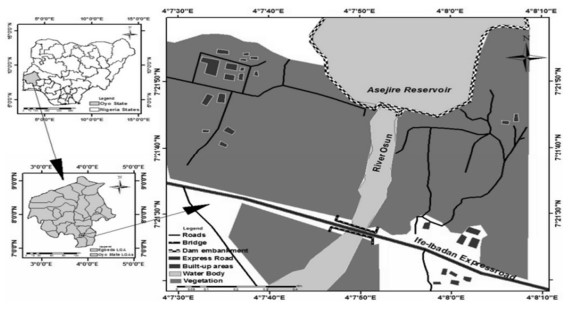
|
Length-weight relationship and condition factor: The relation between length and weight was computed using the formula9:
where, W is the total weight in grams, L is the total length in cm, and a and b are the constants whose values were estimated by least squares regression analysis. The condition factor was estimated using the relationship:
where, W is the fish weight (g), and L is the total length (cm)
Growth parameters: Growth parameters were estimated with Bertalanffy growth functions using the ELEFAN (Electronic Length Frequency Analysis) method9:
where, Lt is the length at age t, L∞ represents the asymptotic fish length, K is a relative growth coefficient, t is the fish age, and t0 is the hypothetical time at which the length of the fish is zero.
The species longevity was estimated following10 equation:
Where:
| tmax | = | Species longevity | |
| t0 | = | Hypothetical time at which the length of the fish is zero | |
| K | = | Growth coefficient |
The total mortality (Z) was estimated using the length-converted catch curve method11.
Then et al.12 empirical formula was used to estimate natural mortality based on life history traits, size at maturity and environmental factors:
Where:
| M | = | Natural mortality | |
| K | = | Relative growth coefficient | |
| L∞ | = | Asymptotic fish length |
Fishing mortality was, however, calculated using the Qamar et al.13 equation:
Where:
| F | = | Fishing mortality | |
| Z | = | Total mortality | |
| M | = | Natural mortality |
The exploitation rate was calculated using the formula of Mudjirahayu et al.14:
Where:
| E | = | Exploitation rate | |
| Z | = | Total mortality | |
| F | = | Fishing mortality |
Statistical analysis: The TropFishR package for fisheries analysis was used to analyse the data obtained for estimation of the growth and mortality parameters, exploitation rate, size, and composition of a fish stock utilizing virtual population analysis (VPA) and assessing stock status with yield prediction and production models.
RESULTS
Condition factor, lengths, and body weight characteristics: The condition factor, lengths, and body weight attributes of Chrysichthys nigrodigitatus samples in the study were given in Table 1. In all, 629 C. nigrodigitatus specimens were collected, which ranged from 10.4 to 31.6 cm (18.92±2.48 cm) in fork length and from 13.5 to 40.3 g in total length (24.41±0.13 cm). The weight distribution of all the specimens observed varied between 11.0 and 320.0 g with a mean of 76.44±30.6 g. The condition factor of C. nigrodigitatus population in Asejire Lake was 0.51±0.13. The scatter plot of length-weight relationship of C. nigrodigitatus in the Asejire Lake during the period of study was shown in Fig. 2. An exponential relationship as revealed between the fork length (FL) and body weight (W) of C. nigrodigitatus is expressed by the regression equation:
The t-test conducted showed no significant difference (p<0.05) between the values of ‘b’ (2.9272) obtained and the expected value of isometric growth i.e., 3, which implies an isometric growth coefficient (Table 2). Also, fork-length is significant linear predictor of body weight (p<0.01) with a predictive ability of 94%.
| Table 1: | Condition factor, lengths, and body weight characteristics of Chrysichthys nigrodigitatus samples in Asejire Lake | |||
| Parameter | Values |
| Number of samples | 629 |
| Fork length range (cm) | 10.40-31.60 |
| Mean fork length (cm) | 18.92±2.48 |
| Total length range (cm) | 13.50-40.30 |
| Mean total length (cm) | 24.41±0.13 |
| Body weight range (g) | 11.00-320.00 |
| Mean body weight (g) | 76.44±30.60 |
| Mean condition factor (K) | 0.51±0.13 |
| Table 2: | Regression coefficient of the transformed length-weight relationship of Chrysichthys nigrodigitatus collected from Asejire Lake | |||
| Coefficients | Estimate | Standard error | t value | Pr(>|t|) | 2.50% | 97.50% |
| Intercept | -1.877 | 0.0383 | -49.0544 | 8.2156e-217*** | -1.9521 | -1.8019 |
| Log.FL | 2.9272 | 0.03 | 97.4965 | 0.0000*** | 2.8683 | 2.9862 |
| Significance codes: 0'*** '0.001'** '0.01' *'0.05'. '0.1' '1 | ||||||
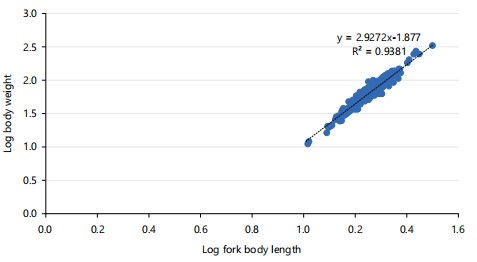
|
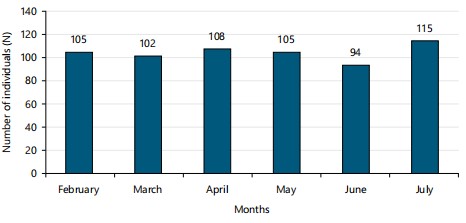
|
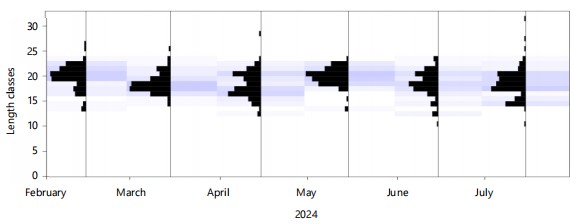
|
The distribution of data from the study showed strong monthly variability in the number of individuals (unbalanced data), ranging from 105 in February to 115 in July (Fig. 3). It was also observed that the length frequency distribution exhibited the greatest variability in April, June, and July. Meanwhile, the extremely small and large individuals encountered during the study suggested June and July as the spawning period (Fig. 4 and 5). The density plot of the length frequency distribution exhibited three modes corresponding to mean length at age 0+(13.1 cm), 1+ (18.8 cm), and 2+ (27.5 cm), respectively (Fig. 6).

|
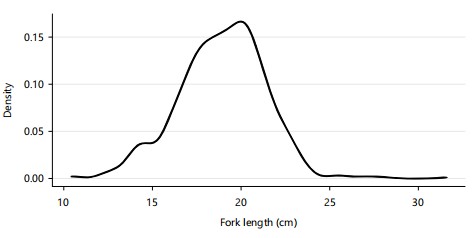
|
The length attained at infinity (L∞) and growth coefficient (K) values were 36.07 cm and 0.38 y, respectively. The estimated L∞ (36.07 cm) is greater than the observed maximum size of 31.60 cm, an indication that Chrysichthys nigrodigitatus does not attain full size potential in the Asejire Reservoir. The estimated life span for the species in the habitat was 3.5 years. The length-converted catch curve of C. nigrodigitatus is shown in Fig. 7a-b. Instantaneous total mortality (Z) was estimated as 2.54 year–1. The natural and fishing mortality rates were estimated at M = 0.67 and F = 1.91 year–1, respectively. The current exploitation rate (E) was obtained at 0.75.
DISCUSSION
In the present study, the average weight of the sampled fish varied from 11 to 320 g. Most of the specimens encountered have an average weight of about 80 to 100 g, which implies excessive exploitation of the fish and degradation of ecological conditions15. Though these results are somewhat comparable to those recorded (25.0-546 g) by Nurudeen and Kareem16 for Chrysichthys nigrodigitatus in the same Lake. Silga et al.17, also noted that these low catch weights signify non-compliance with the regulations concerning the size of the mesh of the nets. The linear relationship between the fork length and body weight of C. nigrodigitatus in the study reflects an isometric growth pattern where the length increased proportionately to weight. This indicates that the fish maintains dimensional equality. This result is consistent with the growth pattern reported in a population of C. nigrodigitatus from Lake Akata (2.95) in Benue State, Nigeria18, and Lake Ahozon (2.99) in Ouidah City in Southern Benin19. However, this result is in contrast with Nurudeen and Kareem16 and Kareem et al.1, who reported a negative allometric growth for C. nigrodigitatus in Asejire and Erelu Lakes, Oyo State, Nigeria. These results agree with the view of Abdul et al.20, who reported that fish do not retain the same shape throughout their lifespan. Some of the factors responsible for the fluctuation in LWR and growth patterns of fish species as observed by Oboh and Olowo21 include gear selectivity, time of the year, sex, and differences in seasons. The correlation coefficient obtained in this study (0.93) is close to unity (1) which signifies a strong relationship between the length and weight of C. nigrodigitatus. This result coincides with the findings of Nurudeen and Kareem16 on C. nigrodigitatus from the same water body.
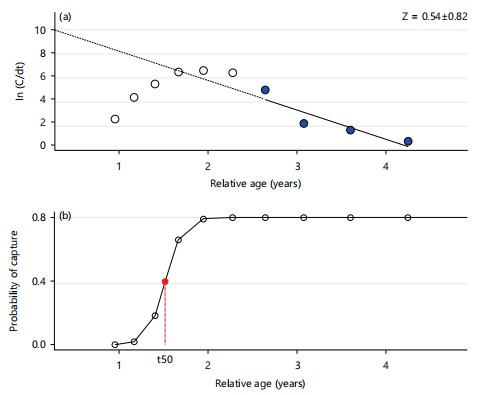
|
The mean condition factor (K) estimated in this study was 0.51±0.13, which was comparatively low to the results of Abidemi-Iromini and Bello-Olusoji22, who reported 1.64 for C. nigrodigitatus in Asejire Lake. Also, Abdul et al.20 and Ikongbeh et al.18 recorded 0.83-0.97 and 1.62±0.02 for C. nigrodigitatus in Lekki Lagoon, Lagos, and Lake Akata, Benue, respectively. According to Ricker23, the estimation of the condition factor of fish species from length and weight relationship is based on the hypothesis that heavier fish of a particular length are in a better physiological condition. This result implies that the fish in this study lack good general environmental conditions as predicated by le Cren24. The values of L∞ (cm FL) and K (year) of the von Bertalanffy growth parameter for the study were, respectively estimated to be 36.07 and 0.38. The asymptotic length (L∞) estimated in this study was above 25.70 cm, reported by Antigha et al.25 in the Cross River estuary, Southeastern Nigeria. This L∞ value is also generally close to the value (37.28 cm) observed by Ikongbeh et al.18 from Lake Akata, Benue State, Nigeria. These results could imply that the stock of C. nigrodigitatus being exploited was mostly the medium-sized individuals as larger C. nigrodigitatus with L∞ of 60.90 and 120.20 cm have been reported in Ajagbe et al.26 and lower Cross River, Nigeria27, respectively. However, Frota et al.28 reported that the maximum size attainable in fishes is location-specific. Further, the K value in the present study was lower than 0.96 and 0.53 year–1 reported by Ikongbeh et al.18 and Ajagbe et al.26, respectively. However, Branstetter29 noted that fish species with a growth coefficient in the range of K (0.20-0.50 year–1 and above) would be characterized by rapid growth.
The instantaneous total mortality (Z) of 2.54 year–1 in this study is low compared to 3.29 year–1 recorded for C. nigrodigitatus in Ikere-Gorge, Southwestern Nigeria27, but slightly higher than 2.72 year–1 reported by Antigha et al.25 in Mid Cross River Flood System, Southeastern Nigeria. The variations in results have been attributed to differences in environmental parameters and the level of fishing effort30. The estimated natural mortality (0.67 year–1) and fishing mortality (1.91 year–1) recorded in the present study were lower than M = 1.58 and F = 2.73 year–1 reported by Udoh et al.27 in the lower Cross River, Nigeria. The current study indicates that (M) was lower than (F), which implies overfishing. The size at which the youngest individuals are captured corresponds to 15.90 cm at ages 1.5 years. The exploitation status of 0.75 (>0.5 threshold) suggests imminent collapse of the fish due to an unsustainable level of fishing, causing growth overfishing (excessive harvesting of young immature fish). With an estimated lifespan of 3.5 years for C. nigrodigitatus in Asejire Lake, the species has a relatively short life cycle, making it particularly vulnerable to fishing pressures. Short-lived species often struggle to recover from overfishing, especially if younger individuals are targeted. This implies that they are normally caught before they have had the chance to grow enough to contribute substantially to the stock biomass, which indicates over-fishing. Ajagbe et al.26 obtained a similar longevity of 3.13 years for C. nigrodigitatus in Ikere-gorge, Iseyin, Nigeria. In contrast, Udoh et al.27 reported 2 2-year potential longevity for C. nigrodigitatus from the lower Cross River, Nigeria.
The potential limitation of this study is essentially the paucity of funds to drive the research, which is responsible for the limited duration and sample size of the research. This study ought to cover two seasons, i.e., twelve months, to show seasonality with more samples covered if there is adequate funding. Further studies are, however, recommended to explore the seasonality effect on the fish stock. This will ensure more robust data to formulate a reliable and sustainable management policy for the fish stock in this Lake.
CONCLUSION
The research concluded that C. nigrodigitatus in Asejire reservoir, Nigeria, growth was isometric with a low condition factor, indicating the poor state of well-being. The length at infinity of this species indicates that the stock was being exploited using a net of an inappropriate mesh size. However, the growth coefficient revealed that the species is fast-growing and short-lived. Mortality parameters indicated an over-exploitation of the stock of C. nigrodigitatus in Asejire Lake. There is, thus, the need to improve the condition of the lake and adopt sustainable management strategies for the species in Asejire Lake.
SIGNIFICANCE STATEMENT
This study gives critical data on the dynamics of the Chrysichthys nigrodigitatus population in Asejire Lake, Oyo State, Nigeria. Current findings revealed that all the estimated parameters were within an acceptable range, however, the exploitation of C. nigrodigitatus is not sustainable on the Lake. The results suggest that the values of fishing mortality and exploitation rate is high, and dangerous for Chrysichthys nigrodigitatus population in Asejire Lake.
ACKNOWLEDGMENTS
The authors are grateful to the fishermen at Asejire Lake, Nigeria, for their cooperation during fish sample collection. We are also thankful to leadership of the Department of Aquaculture and Fisheries Management for providing conducive environment for the research.
REFERENCES
- Kareem, O.K., A.N. Olanrewaju and O. Orisasona, 2015. Length-weight relationship and condition factor of Chrysichythys nigrodigitatus and Schilbe mystus in Erelu Lake, Oyo State, Nigeria. J. Fish. Livest. Prod., 3.
- Pauly, D. and D. Zeller, 2016. Catch reconstructions reveal that global marine fisheries catches are higher than reported and declining. Nat. Commun., 7. https://doi.og/10.1038/ncomms10244
- Olanrewaju, A.N., E.K. Ajani, O.K. Kareem and O. Orisasona, 2017. Relationship between physico-chemical parameters and reproductive indices of Parachanna obscura (Gunther 1861) in Eleyele Reservoir, Ibadan, Nigeria. Eur. J. Exp. Biol., 7.
- Barange, M., T. Bahri, M.C.M. Beveridge, K.L. Cochrane, S. Funge-Smith and F. Poulain, 2019. Impacts of Climate Change on Fisheries and Aquaculture: Synthesis of Current Knowledge, Adaptation and Mitigation Options. FAO, Rome, Italy, ISBN: 9789251306079, Pages: 652.
- Karimzadeh, G., 2011. Study of the natural and fishing mortality and exploitation rates of bigeye kilka (Clupeonella grimmi) in the Southeast part of the Caspian Sea (Babolsar). Afr. J. Agric. Res., 6: 676-680.
- Aladesanmi, T.O., O.G. Oladipo and G.A. Ali, 2013. Aquatic environmental contamination: The fate of Asejire Lake in South-Western Nigeria. Afr. J. Environ. Sci. Technol., 7: 482-489.
- Ipinmoroti, M.O. and A.O. Iyiola, 2022. Diversity, distribution and abundance of fish species in Lake Asejire, Oyo State, Nigeria. Zoologist, 21: 49-56.
- Kareem, K., N. Olanrewaju and B. Igbaro, 2021. Growth pattern, diet and tropical niche breadth of the Nile silver catfish, Schilbe mystus (Linne 1758) in Asejire Lake, Southwestern, Nigeria. Egypt. J. Aquat. Biol. Fish., 25: 677-687.
- Wang, K., C. Zhang, M. Sun, B. Xu, Y. Ji, Y. Xue and Y. Ren, 2021. Fishing pressure and lifespan affect the estimation of growth parameters using ELEFAN. Fish. Res., 238.
- Pauly, D., 1983. Some Simple Methods for the Assessment of Tropical Fish Stocks. FAO, Rome, Italy, Pages: 52.
- Sparre, P. and S.C. Venema, 1992. Introduction to Tropical Fish Stock Assessment-Part 1: Manual. FAO, Rome, Italy, Pages: 376.
- Then, A.Y., J.M. Hoenig, N.G. Hall and D.A. Hewitt, 2015. Evaluating the predictive performance of empirical estimators of natural mortality rate using information on over 200 fish species. ICES J. Mar. Sci., 72: 82-92.
- Qamar, N., S.K. Panhwar and S. Brouwer, 2016. Population characteristics and biological reference point estimates for two carangid fishes, Megalaspis cordyla and Scomberoides tol, in the Northern Arabian Sea Coast of Pakistan. Pak. J. Zool., 48: 869-874.
- Mudjirahayu, R. Bawole, U.N.W.J. Rembet, A.S. Ananta, F. Runtuboi and R. Sala, 2017. Growth, mortality and exploitation rate of Plectropomus maculatus and P. oligocanthus (Groupers, Serranidae) on Cenderawasih Bay National Park, Indonesia. Egypt. J. Aquat. Res., 43: 213-218.
- Écoutin, J.M. and J.J. Albaret, 2003. Length-weight relationship for 52 fish species from West African estuaries and lagoons [In French]. Cybium, 27: 3-9.
- Nurudeen, O.A. and K.O. Kareem, 2023. Aspect of reproductive biology of Chrysichthys nigrodigitatus (Lacepède 1803) in Asejire Reservoir, Nigeria. Asian J. Biol. Sci., 16: 541-549.
- Silga, R.P., A. Oueda, K. Mano, V. Bance and G.B. Kabre, 2024. Diversity, length-weight structure and condition factor of fish species and physicochemical changes in four reservoirs in Volta Basin, Burkina Faso. Int. J. Biol. Chem. Sci., 18: 633-646.
- Ikongbeh, O.A., F.G. Ogbe, S.G. Solomon and G.A. Ataguba, 2015. Age, growth and mortality of Chrysichthyes nigrodigitatus (Lacépède, 1803) from Lake Akata, Benue State, Nigeria. Asian J. Conserv. Biol., 4: 81-88.
- Adite, A., H.M.A.G. Gbaguidi and M. Ibikounle, 2017. Growth patterns and Fulton's condition factor of the silver catfish Chrysichthys nigrodigitatus (Actinopterygii: Siluriformes: Claroteidae) from a sand-dragged man-made lake of Benin. Afr. J. Agric. Res., 12: 2283-2294.
- Abdul, W.O., M.L. Bajela, A.M. Quadri and E.O. Adekoya, 2023. Length-weight relationship and condition factor of some commercial fish species in Lekki Lagoon, Southwest Nigeria. Ife J. Agric., 35: 78-87.
- Oboh, I.P. and U.C. Olowo, 2024. Length-weight relationship, condition factor (k) and sex ratio of four fish species from River Siluko, Edo State, Nigeria. Niger. J. Fish., 13: 1058-1068.
- Abidemi-Iromini, A.O. and O.A. Bello-Olusoji, 2021. Condition factor and length-weight relationship of Chrysichthys nigrodigitatus from Asejire Reservoir and Lagos Lagoon, South-West, Nigeria. Int. J. Fish. Aquat. Stud., 9: 127-131.
- Ricker, W.E., 1973. Linear regressions in fishery research. J. Fish. Res. Board Can., 30: 409-434.
- le Cren, E.D., 1951. The length-weight relationship and seasonal cycle in gonad weight and condition in the perch (Perca fluviatilis). J. Anim. Ecol., 20: 201-219.
- Antigha, A.A., A.K. Armah and E. Nyarko, 2023. The significance of community-based management in the structure and sustainability of the fisheries in Cross River Estuary, Nigeria. Indo Pac. J. Ocean Life, 5: 29-41.
- Ajagbe, S.O., D.O. Odulate, R.O. Ajagbe, O.S. Ariwoola and F.I. Abdulazeez et al., 2021. Population dynamics of Chrysichthys nigrodigitatus (Lacépède, 1803) in Ikere-gorge, Oyo State, Nigeria. Ghana J. Agric. Sci., 56: 79-86.
- Udoh, J.P., J.E. Ukpatu and O.M. Udoidiong, 2015. Population dynamics of Chrysichthys nigrodigitatus (Lacépède, 1803) in lower Cross River, Nigeria. Croatian J. Fish., 73: 103-114.
- Frota, L.O., P.A.S. Costa and A.C. Braga, 2004. Length-weight relationships of marine fishes from the central Brazilian coast. NAGA WorldFish Center Quart., 27: 20-26.
- Branstetter, S., 1987. Age and growth estimates for blacktip, Carcharhinus limbatus, and spinner, C. brevipinna, sharks from the Northwestern Gulf of Mexico. Copeia, 1987: 964-974.
- Amponsah, S.K.K., 2022. Stock assessment indicators for sustainable exploitation of Chrysichthys walkeri in Lake Volta, Ghana, West Africa. J. Limnol. Freshwater Fish. Res., 8: 235-242.
How to Cite this paper?
APA-7 Style
Kazeem,
K.O., Nurudeen,
O.A., Victor,
O.F. (2025). Population Dynamics of Chrysichthys nigrodigitatus (Lacépède, 1803) in a Tropical Man-Made Lake, Southwestern Nigeria. Trends in Environmental Sciences, 1(3), 239-248. https://doi.org/10.21124/tes.2025.239.248
ACS Style
Kazeem,
K.O.; Nurudeen,
O.A.; Victor,
O.F. Population Dynamics of Chrysichthys nigrodigitatus (Lacépède, 1803) in a Tropical Man-Made Lake, Southwestern Nigeria. Trends Env. Sci 2025, 1, 239-248. https://doi.org/10.21124/tes.2025.239.248
AMA Style
Kazeem
KO, Nurudeen
OA, Victor
OF. Population Dynamics of Chrysichthys nigrodigitatus (Lacépède, 1803) in a Tropical Man-Made Lake, Southwestern Nigeria. Trends in Environmental Sciences. 2025; 1(3): 239-248. https://doi.org/10.21124/tes.2025.239.248
Chicago/Turabian Style
Kazeem, Kareem, Oladeji, Olanrewaju Adewale Nurudeen, and Oluwale Femi Victor.
2025. "Population Dynamics of Chrysichthys nigrodigitatus (Lacépède, 1803) in a Tropical Man-Made Lake, Southwestern Nigeria" Trends in Environmental Sciences 1, no. 3: 239-248. https://doi.org/10.21124/tes.2025.239.248

This work is licensed under a Creative Commons Attribution 4.0 International License.




